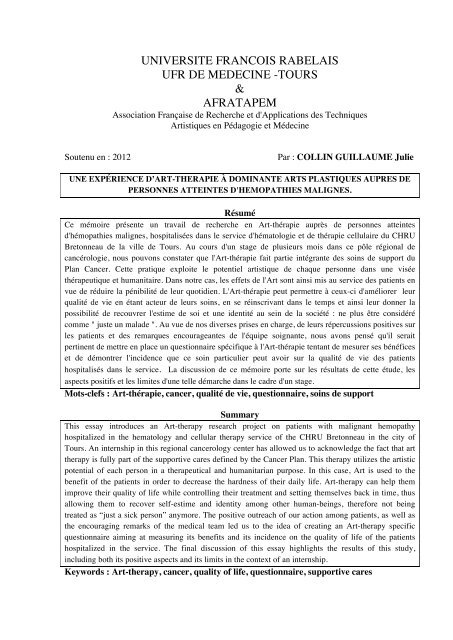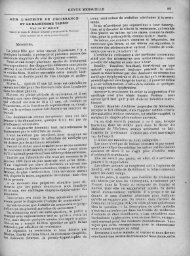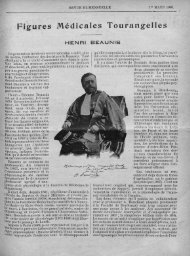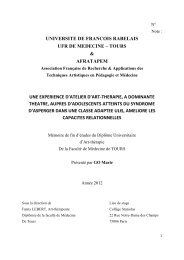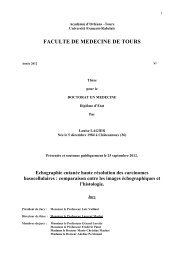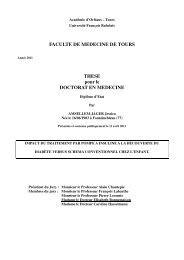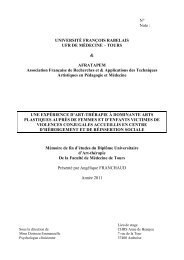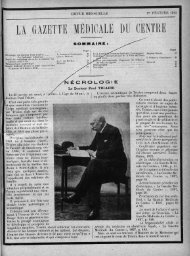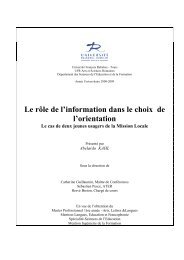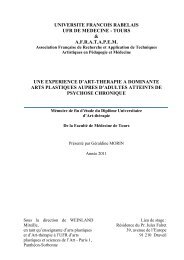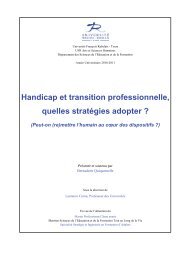une expérience d'art-therapie à dominante arts plastiques aupres de ...
une expérience d'art-therapie à dominante arts plastiques aupres de ...
une expérience d'art-therapie à dominante arts plastiques aupres de ...
Create successful ePaper yourself
Turn your PDF publications into a flip-book with our unique Google optimized e-Paper software.
UNIVERSITE FRANCOIS RABELAISUFR DE MEDECINE -TOURS&AFRATAPEMAssociation Française <strong>de</strong> Recherche et d'Applications <strong>de</strong>s TechniquesArtistiques en Pédagogie et Mé<strong>de</strong>cineSoutenu en : 2012Par : COLLIN GUILLAUME JulieUNE EXPÉRIENCE D’ART-THERAPIE À DOMINANTE ARTS PLASTIQUES AUPRES DEPERSONNES ATTEINTES D'HEMOPATHIES MALIGNES.RésuméCe mémoire présente un travail <strong>de</strong> recherche en Art-thérapie auprès <strong>de</strong> personnes atteintesd'hémopathies malignes, hospitalisées dans le service d'hématologie et <strong>de</strong> thérapie cellulaire du CHRUBretonneau <strong>de</strong> la ville <strong>de</strong> Tours. Au cours d'un stage <strong>de</strong> plusieurs mois dans ce pôle régional <strong>de</strong>cancérologie, nous pouvons constater que l'Art-thérapie fait partie intégrante <strong>de</strong>s soins <strong>de</strong> support duPlan Cancer. Cette pratique exploite le potentiel artistique <strong>de</strong> chaque personne dans <strong>une</strong> viséethérapeutique et humanitaire. Dans notre cas, les effets <strong>de</strong> l'Art sont ainsi mis au service <strong>de</strong>s patients envue <strong>de</strong> réduire la pénibilité <strong>de</strong> leur quotidien. L'Art-thérapie peut permettre <strong>à</strong> ceux-ci d'améliorer leurqualité <strong>de</strong> vie en étant acteur <strong>de</strong> leurs soins, en se réinscrivant dans le temps et ainsi leur donner lapossibilité <strong>de</strong> recouvrer l'estime <strong>de</strong> soi et <strong>une</strong> i<strong>de</strong>ntité au sein <strong>de</strong> la société : ne plus être considérécomme " juste un mala<strong>de</strong> ". Au vue <strong>de</strong> nos diverses prises en charge, <strong>de</strong> leurs répercussions positives surles patients et <strong>de</strong>s remarques encourageantes <strong>de</strong> l'équipe soignante, nous avons pensé qu'il seraitpertinent <strong>de</strong> mettre en place un questionnaire spécifique <strong>à</strong> l'Art-thérapie tentant <strong>de</strong> mesurer ses bénéficeset <strong>de</strong> démontrer l'inci<strong>de</strong>nce que ce soin particulier peut avoir sur la qualité <strong>de</strong> vie <strong>de</strong>s patientshospitalisés dans le service. La discussion <strong>de</strong> ce mémoire porte sur les résultats <strong>de</strong> cette étu<strong>de</strong>, lesaspects positifs et les limites d'<strong>une</strong> telle démarche dans le cadre d'un stage.Mots-clefs : Art-thérapie, cancer, qualité <strong>de</strong> vie, questionnaire, soins <strong>de</strong> supportSummaryThis essay introduces an Art-therapy research project on patients with malignant hemopathyhospitalized in the hematology and cellular therapy service of the CHRU Bretonneau in the city ofTours. An internship in this regional cancerology center has allowed us to acknowledge the fact that arttherapy is fully part of the supportive cares <strong>de</strong>fined by the Cancer Plan. This therapy utilizes the artisticpotential of each person in a therapeutical and humanitarian purpose. In this case, Art is used to thebenefit of the patients in or<strong>de</strong>r to <strong>de</strong>crease the hardness of their daily life. Art-therapy can help themimprove their quality of life while controlling their treatment and setting themselves back in time, thusallowing them to recover self-estime and i<strong>de</strong>ntity among other human-beings, therefore not beingtreated as “just a sick person” anymore. The positive outreach of our action among patients, as well asthe encouraging remarks of the medical team led us to the i<strong>de</strong>a of creating an Art-therapy specificquestionnaire aiming at measuring its benefits and its inci<strong>de</strong>nce on the quality of life of the patientshospitalized in the service. The final discussion of this essay highlights the results of this study,including both its positive aspects and its limits in the context of an internship.Keywords : Art-therapy, cancer, quality of life, questionnaire, supportive cares


